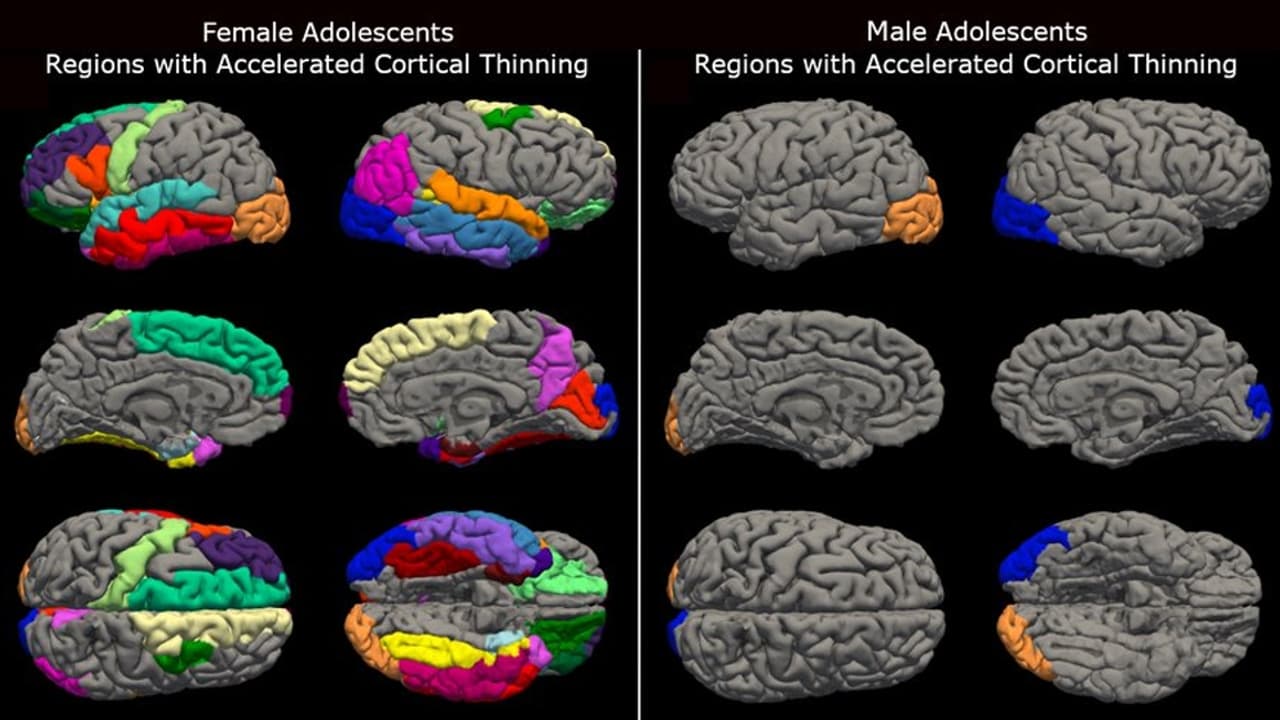In a striking revelation, a pioneering study from the University of Washington has unveiled that the adolescent brains of girls aged at a considerably accelerated pace during the Covid pandemic.
In a striking revelation, a pioneering study from the University of Washington has unveiled that the adolescent brains of girls aged at a considerably accelerated pace during the Covid pandemic. Published on Monday in the Proceedings of the National Academy of Sciences, the research employed neuroimaging to explore cortical thinning—a phenomenon where the brain prunes redundant synapses and reduces its outer layer.

Typically a normal part of brain maturation, cortical thinning becomes a more pronounced process under stressful conditions. This study, conducted before and after the onset of the Covid-19 lockdowns, revealed that social isolation had a profound impact on this process, with girls experiencing a thinning of their cortical layers at a staggering rate compared to their male counterparts.
Scans from 2021, following the initial easing of lockdown restrictions, indicated that both boys and girls had undergone rapid cortical thinning. However, the disparity was glaringly evident: girls' cortical thinning had accelerated by an average of 4.2 years beyond the expected rate, while boys' thinning had advanced by a mere 1.4 years. “That is a stunning difference,” remarked Patricia K. Kuhl, a director at the Institute for Learning and Brain Sciences at the University of Washington and one of the study’s principal authors. “A girl who came in at 11, and then returned to the lab at age 14, now has a brain that looks like an 18-year-old’s.”
Dr. Kuhl attributed this pronounced shift to “social deprivation caused by the pandemic,” emphasizing that adolescent girls, being inherently more reliant on peer interaction for emotional support, were disproportionately affected by the lockdowns. The impact was pervasive, with alterations observed across all lobes and both hemispheres of the brain. “The difference between the genders is just as clear as night and day,” Dr. Kuhl observed.
While prior studies have highlighted a deterioration in teen well-being during the pandemic, this research introduces tangible evidence of physical changes. However, researchers urge caution in interpreting accelerated cortical thinning as outright damage. Ronald E. Dahl, who directs the Institute of Human Development at the University of California, Berkeley, noted that “thinning is not necessarily an indication of a problem,” suggesting it may reflect a maturational change rather than pathological damage.
Initially, the study engaged 160 children and adolescents, capturing baseline data in 2018. The pandemic disruptions, however, impeded the second wave of data collection in 2020. By 2021, as subjects emerged from extended stress, the research became a “natural experiment,” with approximately 130 subjects returning for follow-up testing.
The dramatic findings revealed significant deviations from typical brain development patterns, with girls’ brains exhibiting accelerated thinning in 30 regions, including those critical for facial recognition, emotion processing, and language comprehension. In contrast, accelerated thinning in boys’ brains was confined to two visual processing areas.
Despite the dramatic findings, the permanence of these changes remains uncertain. Dr. Kuhl speculated that improved social interactions post-pandemic might mitigate some of the observed effects.
“Let’s say that girl who comes back at age 14 has her social life restored and reconnects with friends. The stress may not be entirely alleviated, but at least she’s got that release valve.”
Pediatric psychiatrist and brain researcher Bradley S. Peterson, who was not involved in the study, noted some limitations, including discrepancies in the pre- and post-pandemic data sets and the potential influence of factors beyond social isolation, such as increased screen time and family stress. “Accelerated thinning could represent nature’s adaptive response,” Peterson suggested, hinting that the brain’s adjustments during lockdown might enhance resilience in the long run.
As the scientific community delves deeper into these findings, the study underscores the profound impact of pandemic-induced social isolation on adolescent brain development, shedding light on the intricate ways in which stress and isolation shape the young mind.
